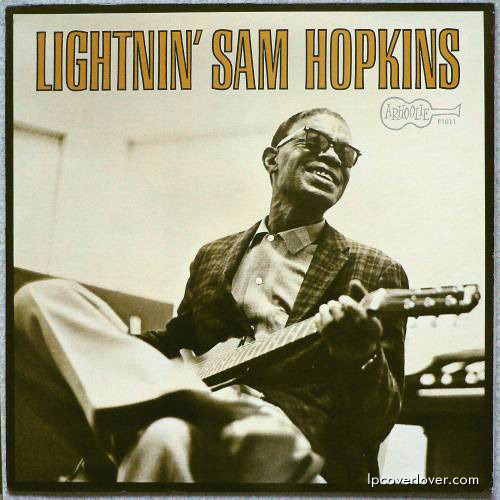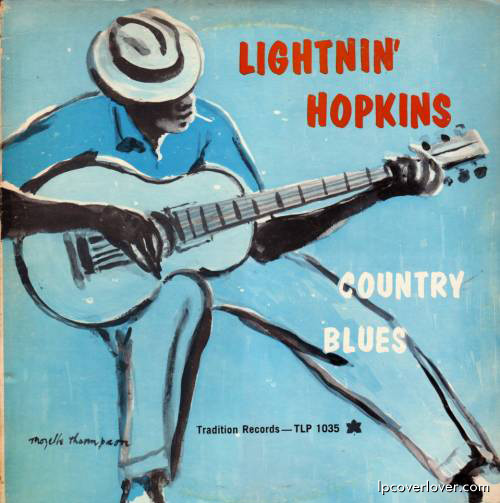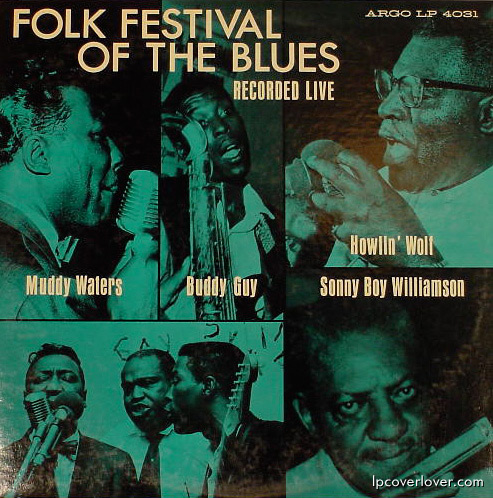Lightnin’ Sam Hopkins

“Hi from France! A rare LP of raw blues on Arhoolie records ” ¦ by the late Great Lightnin’Sam Hopkins” -Alain Mallaret
You are currently browsing the archive for the Blues category.

“Hi from France! A rare LP of raw blues on Arhoolie records ” ¦ by the late Great Lightnin’Sam Hopkins” -Alain Mallaret

“I guess it’s about 35 years ago when one afternoon I found this jewel in my hometown’s only record store. It’s the original from 1959, the shop’s owner looked happy to sell it, as I remember. It must have been there on his shelf since that time, ignored by everyone. As I was very young I’d never heard the name “Lightnin’ Hopkins” before and I only took a look at the Blues records ’cause there were these older guys hanging around the Jazz and Classical records giving me no chance at all. I loved the cover from the first sight and the music astonished me. I took the record home and it’s still one of my favorites after all these years and thousands of LPs that came after it.” — K. Reineke, Germany
“Blues & Ballads” Lonnie Johnson with Elmer Snowden Prestige/Bluesville (1960)
This beautiful album was engineered by Rudy Van Gelder in his Englewood Cliffs, New Jersey, home studio where so much jazz history was made. It features guitar innovators Lonnie Johnson and Elmer Snowden together for the first time–despite a friendship going back to the 1920s when both appeared on some of the earliest jazz and blues 78s. Johnson, the father of single-note six-string soloing, is in marvelous voice on this selection of blues, ballads, and jazz, crooning the double-entendre “Jelly Roll Baker” and the heartache-laden “Back Water Blues” (a Bessie Smith tune he first cut in 1927) with a marksman’s sense of pitch and chilling nuance. Snowden serves mostly as accompanist. But these men play so closely that they seem to be sharing every breath. –Ted Drozdowski
Howlin’ Wolf – “The Real Folk Blues” Recorded in Chicago, Illinois between 1956 & 1965. (In the mid-’60s, Chess Records released a great series of compilations by some of its best blues artists, all of them called THE REAL FOLK BLUES) “Killing Floor,” “Built for Comfort”,”Three Hundred Pounds of Joy”, “Natchez Burning,” “Tail Dragger” and more.
Personnel: Howlin’ Wolf (vocals, guitar, harmonica); Hubert Sumlin*, Willie Johnson, Otis “Smokey” Smothers, Jody Williams (guitar); J.T. Brown (tenor saxophone); Donald Hankins (baritone saxophone); Johnny Jones, Lafayette Leake, Hosea Lee Kennard (piano); Willie Dixon, Buddy Guy, Andrew Palmer (bass); Sammy Lay, Earl Phillips, Junior Blackman (drums).
“Howlin’ Wolf ranks among the most electrifying performers in blues history, as well as one of its greatest characters. He was a ferocious, full-bodied singer whose gruff, rasping vocals embodied the blues at its most unbridled. A large man who stood more than six feet tall and weighed nearly 300 pounds, Howlin’ Wolf cut an imposing figure, which he utilized to maximum effect when performing. Howlin’ Wolf cut his greatest work in the Fifties for the Chicago-based Chess Records. Many songs with which he is most closely identified – “Spoonful,” “Back Door Man,” “Little Red Rooster” and “I Ain’t Superstitious” – were written for him by bluesmen Willie Dixon, a fixture at Chess Records who also funneled material to Wolf’s main rival, Muddy Waters. Howlin’ Wolf himself was an estimable songwriter, responsible for such raw classics as “Killing Floor,” “Smokestack Lightning” and “Moanin’ at Midnight.”
In 1910, Howlin’ Wolf was born on a Mississippi plantation in the midst of a blues tradition so vital it remains the underpinning for much of today’s popular music. His birth name was Chester Arthur Burnett; “Howlin’ Wolf” was a nickname he picked up in his youth. He was exposed to the blues from an early age through such performers as Charley Patton and Willie Brown, who performed at plantation picnics and juke joints. Wolf derived his trademark howl from the “blue yodel” of country singer Jimmy Rodgers whom he admired. Although he sang the blues locally, it wasn’t until he moved to West Memphis in 1948 that he put together a full-time band. Producer Sam Phillips recorded Howlin’ Wolf at his Memphis Recording Service (later Sun Records) after hearing him perform on radio station KWEM. Some of the material was leased to Chess Records, and in the early Fifties Howlin’ Wolf signed with Chess and moved to Chicago. He remained there until his death. (The Rock and Roll Hall of Fame)
*On a personal note, I just saw Hubert Sumlin playing an all Howlin’ Wolf set with a group including David Johansen and James Blood Ulmer – it killed!
“Color Blind” is a straightforward slice of Texas blues-rock. Out of place on International Artists, the psych label of The Thirteenth Floor Elevators, etc. but a surprisingly hidden gem of roadhouse rock from the late sixties.
“Did You Ever Hear The Blues?” BIG MILLER (1922-1992) does “deep blues” by Langston Hughes. United Artists.
Clarence Horatio Miller’s first influence in music came from his father’s church but he also heard the blues sung by men working on the railroad. In the 30s, while still a student, he formed a band, but with the outbreak of World War II he joined the army. After serving in the Pacific and in Europe, he began entertaining his fellow soldiers. In 1949 he joined Lionel Hampton’s band, then had a five-year spell with Jay McShann. Miller had a commanding style and his rich voice lent itself especially well to the material he favoured. His influences in the blues were Joe Turner, Jimmy Rushing, T-Bone Walker and Jimmy Witherspoon, whom he followed into the McShann band. He also admired the ballad style of Billy Eckstine. Miller’s abiding interest in the blues was such that writer-poet Langston Hughes wrote a series of songs especially for him.
Langston Hughes (1902 – 1967) published more than three dozen books during his life, starting out with poetry and then expanding into novels, short stories, and plays. He is closely associated with the Harlem Renaissance, the flowering of African-American literature and music in New York City following World War One, but he wrote poetry, books, and newspaper columns right through into the 1960s. Hughes’s work often spoke plainly about the lives of ordinary black people, which in later years earned him a reputation as one of the major black voices of the 1900s. His works include the poetry volumes The Weary Blues (1926) and Shakespeare in Harlem (1942), the novel Not Without Laughter (1930), and the short story collection The Ways of White Folks (1934). He wrote two personal memoirs: The Big Sea (1940) and I Wonder as I Wander (1956).
Frank Frost (1936-1999) and the Night Hawks on the Phillips label (via Sam Phillips of Sun Records). Here’s a set of electric, Delta blues and juke joint jumpin’ from 1962 by legendary blues harmonica player, Frank Frost, Jack Johnson and drummer Sam Carr (son of Robert Nighthawk). Together as the Nighthawks, they played together until 1975.
“…the dynamic, Bobby, Bobby Bland!” One of the greatest intros ever to a blazing first song: “36-24-36” and followed by an all-time great album of dynamite blues! On Duke Records.

This is a compilation album that isn’t, a live album that isn’t (at least in a couple of spots), and a Muddy Waters album that isn’t, if one counts the appearances by four other artists on it. But for all things it isn’t, it is also just happens to be one of the greatest and certainly most underrated live blues album of all time, unbelievably crude, raw, and as real as it gets. Originally issued on Chess’ Argo label during the height of the folk music blues revival (hence the goofy title), this was a record that was aimed at a white market who responded in kind. But anybody purchasing it thinking they were getting some nice acoustic coffeehouse blues were in for the reality-check shock of their lives. Recorded on July 26, 1963 at a WPOA live radio broadcast emceed by local Chicago disc jockey Big Bill Hill emanating from the Copacabana Club (hence when this was reissued in 1967, it was retitled Blues From Big Bill’s Copacabana), this features Buddy Guy’s band as the backup band for everybody, augmented by Muddy’s right hand man, pianist Otis Spann. Although Big Bill announces the presence of Little Walter and Sonny Boy Williamson on the album’s intro, they’re no-shows; the studio version of Williamson’s “Bring It On Home” appears here with dubbed on applause (along with the studio version of Guy’s “Worried Blues,” one of the two bits of audio chicanery here). Everything else is just amazingly raw, crude and blistering, with some of the most electrifying Buddy Guy guitar ever committed to tape, droning saxes, thundering drums, and Otis Spann anchoring everything with consummate elegance, as nobody’s bothered to check their tuning in the last half dozen drinks or more. The combination of performances of Guy, Howlin’ Wolf, Willie Dixon, and Sonny Boy in tandem with Waters would certainly checklist this one into ‘various artists’ category, but with half of the 10 tracks here being fronted by Waters, it’s clearly Muddy’s show all the way. His performances of “I Got My Mojo Working,” “She’s 19 Years Old,” “Clouds In My Heart,” “Sitting And Thinking,” and the vocal trio effort with Guy and Dixon on the show opening “Wee Wee Baby” are nothing less than exemplary. No matter how you slice it or end up filing it, one would be very hard pressed indeed to find a live blues album that captures the spirit and a moment in time the way this one does. Unavailable on compact disc as of press time, but worth tracking down in its vinyl incarnations at any cost. ~ Cub Koda, All Music Guide